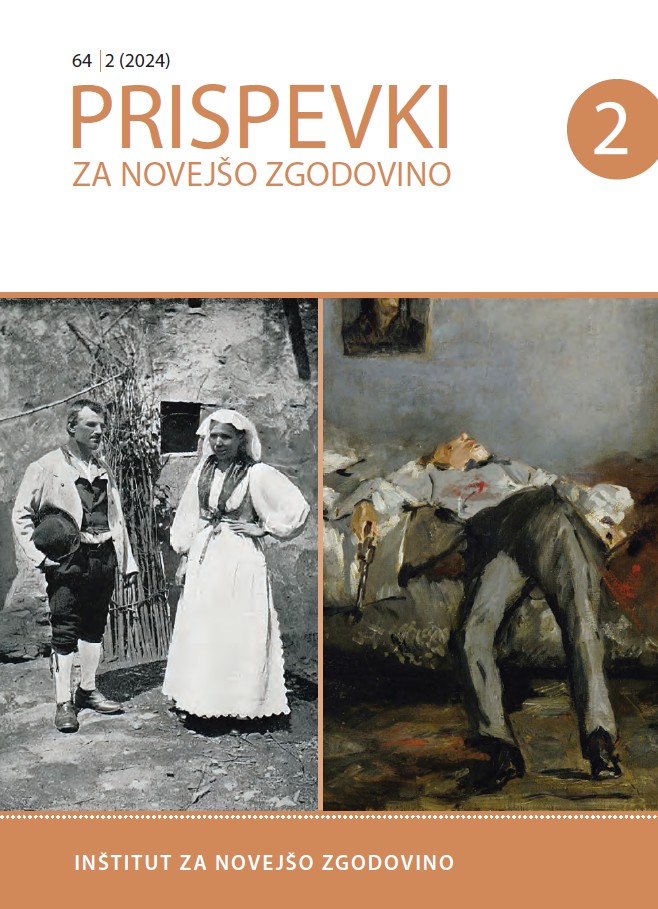Media Portrayals of Suicide's Risk and Protective Factors in Slovenia (1959 – 1999)
DOI:
https://doi.org/10.51663/pnz.64.2.11Keywords:
suicide, risk factors, protective factors, media, attitudesAbstract
This study examined the historical shifts in Slovenian public attitudes towards suicide by analyzing media coverage in two major Slovenian newspapers from 1959 to 1999. We conducted a database search and analyzed 1,785 relevant articles from an initial pool of 13,042 hits. Our findings reveal that the media reported more frequently on risk factors for suicide than on protective factors across the decades. The most frequently mentioned risk factors included individual characteristics such as gender and mental health issues, with community factors becoming more prominent over time. Regarding protective factors, the focus paralleled the emphasis on individual risk factors, with interpersonal factors primarily reported in the 1960s and a growing recognition of community factors by the 1990s. This underscores a broader shift towards holistic understanding of risk and protecitve factors, with community-based approaches in suicide prevention, reflecting evolving public health paradigms.
References
Literature:
Cantor, Christopher. H. “Suicide in the Western World.” In The International Handbook of Suicide and Attempted Suicide, edited by Keith Hawton, Kees van Heeringen, 9–28. John Wiley & Sons, 2002.
Colucci, Ermina, and David Lester.Suicide and Culture: Understanding the Context. Hogrefe Publishing, 2012.
De Leo, Diego, Jose´ Bertolote, and David Lester.“Self-directed Violence.” In World Report on Violence and Health, edited by Etienne G. Krug, Linda L. Dahlberg, James A. Mercy, Anthony B. Zwi and Rafael Lozano, 183-212.. Geneva: World Health Organization, 2002.
Dornik Šubej, Ljuba. Med politiko in zgodovino: življenje in delo dr. Dušana Kermavnerja (1903-1975). Ljubljana: SAZU, 2005.
Engel, George L. “The Need for a New Medical Model: A Challenge for Biomedicine.” Science 196, no. 4286 (1977): 129–36. https://doi.org/10.1126/science.847460.
Grafenauer, Niko. “Oblike slovenskega samomora.” Nova revija 6, no. 57 (1987): 229–246.
Hawton, Keith. Prevention and Treatment of Suicidal Behaviour: From Science to Practice. Oxford: Oxford University Press, 2005.
Hawton, Keith, and Kees van Heeringen. “Suicide.” The Lancet 373, no. 9672 (2009): 1372–1381. https://doi.org/10.1016/S0140-6736(09)60372-X
Hawton, Keith, and Kees van Heeringen, eds. The International Handbook of Suicide and Attempted Suicide. John Wiley & Sons, 2002.
Hjelmeland, Heidi, and BirtheKnizek. “The Emperor’s New Clothes: A Critical Look at the Interpersonal Theory of Suicide.” Death Studies 44, no. 3 (2020): 168–78.. https://doi.org/10.1080/07481187.2018.1527796.
Joiner, Thomas E. Why People Die by Suicide. Harvard University Press, 2005.Karam, Elie G, Zeina N Mneimneh, Hani Dimassi, John A Fayyad, Aimee N Karam, Soumana C Nasser, Somnath Chatterji, and Ronald C Kessler. “Lifetime Prevalence of Mental Disorders in Lebanon: First Onset, Treatment, and Exposure to War.” PLoS Medicine 5, no. 4 (April 1, 2008). https://doi.org/10.1371/journal.pmed.0050061.
Kohrt, Brandon A., Daniel J. Hruschka, Carol M. Worthman, Richard D. Kunz, Jennifer L. Baldwin, Nawaraj Upadhaya, Nanda Raj Acharya, et al. “Political Violence and Mental Health in Nepal: Prospective Study.” British Journal of Psychiatry 201, no. 4 (2012): 268–75. https://doi.org/10.1192/bjp.bp.111.096222.
Marušič, Andrej “Suicide in Slovenia: Lessons Learned for Cross-cultural Psychiatry.” Int Rev Psychiatry 11 (1999): 212–8. https://doi.org/10.1080/09540269974393.
Milčinski, Lev. Izbrana dela. Ljubljana: Univerzitetna psihiatrična klinika Ljubljana, 2016.
Milčinski, Lev. Samomor in Slovenci. Ljubljana: Cankarjeva založba, 1985.
Niederkrotenthaler, Thomas, Martin Voracek, Arno Herberth, Benedikt Till, Markus Strauss, Elmar Etzersdorfer, Brigitte Eisenwort, and Gernot Sonneck. “Role of Media Reports in Completed and Prevented Suicide: Werther v. Papageno Effects.” British Journal of Psychiatry 197, no. 3 (September 2010): 234–43. https://doi.org/10.1192/bjp.bp.109.074633.
O’Connor, Rory C., and Matthew K. Nock. “The Psychology of Suicidal Behaviour.” The Lancet Psychiatry 1, no. 1 (2014): 73–85. https://doi.org/10.1016/S2215-0366(14)70222-6
Pirkis, Jane, and Richard Warwick Blood. “Suicide and the Media. Part I: Reportage in Nonfictional Media.” Crisis 22, no. 4 (2001): 146–54. https://doi.org/10.1027//022-5910.22.4.146.
Repe, Božo "Modernizacije pri Slovencih." Acta Histriae 25, no. 3 (2017): 581-896.
Ringel, Erwin. "The Presuicidal Syndrome." Suicide Life Threat Behav 6, no. 3 (1976): 131–49. https://doi.org/10.1111/j.1943-278X.1976.tb00328.x.
Shneidman, Edwin S. Suicide as Psychache: A Clinical Approach to Self-Destructive Behavior. Jason Aronson, 1993.
Stack, Steven “Suicide: A 15-year Review of the Sociological Literature Part I: Cultural and Economic Factors.” Suicide and Life-Threatening Behavior 30, no. 2 (2000): 145–162.
Stuckler, David, Sanjay Basu, Marc Suhrcke, Adam Coutts, and Martin McKee. “The Public Health Effect of Economic Crises and Alternative Policy Responses in Europe: An Empirical Analysis.” The Lancet 374, no. 9686 (July 2009): 315–23. https://doi.org/10.1016/s0140-6736(09)61124-7.
World Health Organization. Preventing Suicide: A Global Imperative. World Health Organization, 2014.
World Health Organization. "Suicide Huge but Preventable Public Health Problem, Says WHO. World Suicide Prevention Day—10 September." Cent Eur J Public Health 12, no. 4 (2004): 196, 200, 206.
Newspaper sources:
Večer. “Arhiv”. https://ris2016-vecer-com.eviri.ook.sik.si/arhivi/arhiv.aspx
DLIB. “Digitalna knjižnica Slovenije”. https://www.dlib.si
Online sources:
World Health Organization. "European Mortality Database (MDB)." WHO Regional Office for Europe, 2006.
https://gateway.euro.who.int/en/datasets/european-mortality-database/.
Downloads
Published
Issue
Section
License
Copyright (c) 2024 Nuša Zadravec Šedivy, Polonca Borko, Vanja Gomboc, Vita Poštuvan

This work is licensed under a Creative Commons Attribution 4.0 International License.
Authors who publish with this journal agree to the following terms:
- Authors retain copyright and grant the journal right of first publication with the work simultaneously licensed under a Creative Commons Attribution License that allows others to share the work with an acknowledgement of the work's authorship and initial publication in this journal.
- Authors are able to enter into separate, additional contractual arrangements for the non-exclusive distribution of the journal's published version of the work (e.g., post it to an institutional repository or publish it in a book), with an acknowledgement of its initial publication in this journal.
- Authors are permitted and encouraged to post their work online (e.g., in institutional repositories or on their website) prior to and during the submission process, as it can lead to productive exchanges, as well as earlier and greater citation of published work (See The Effect of Open Access).


